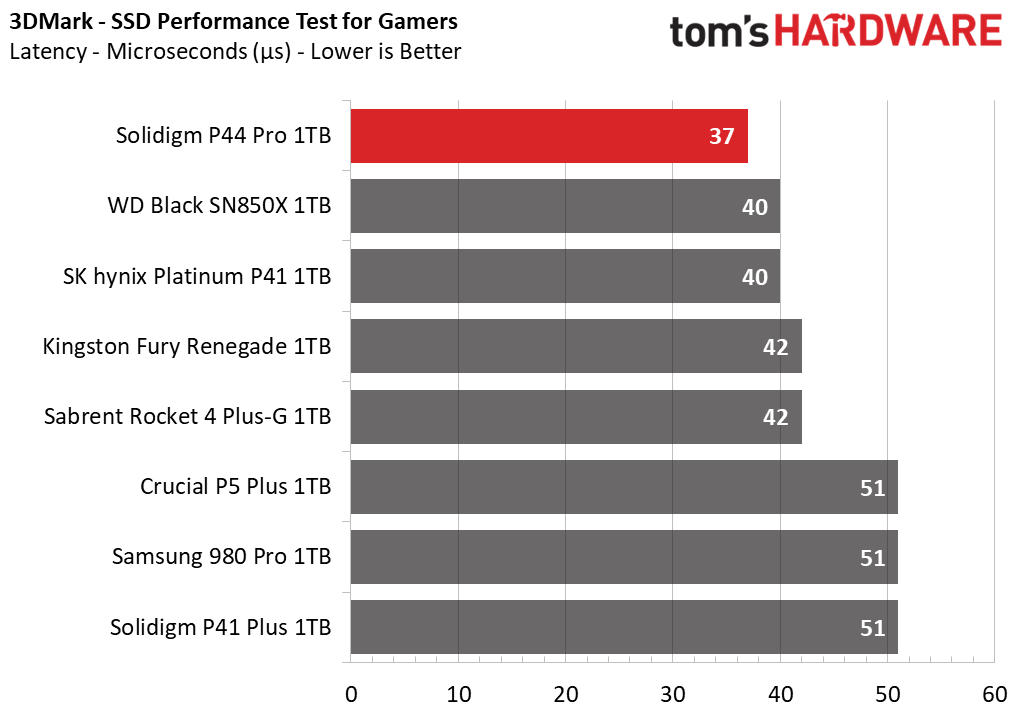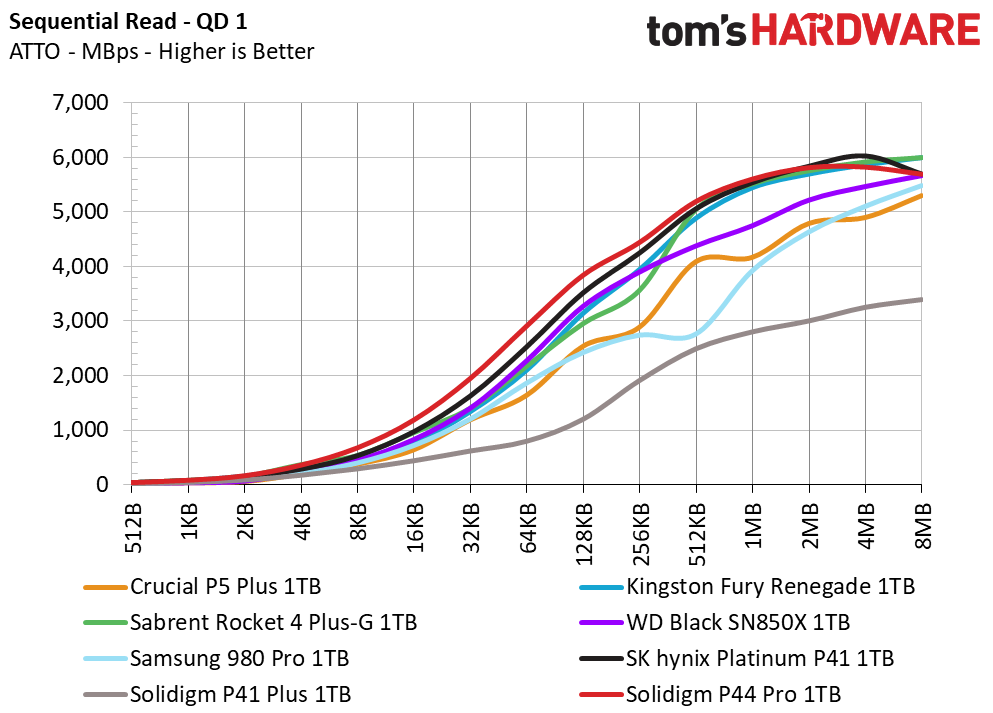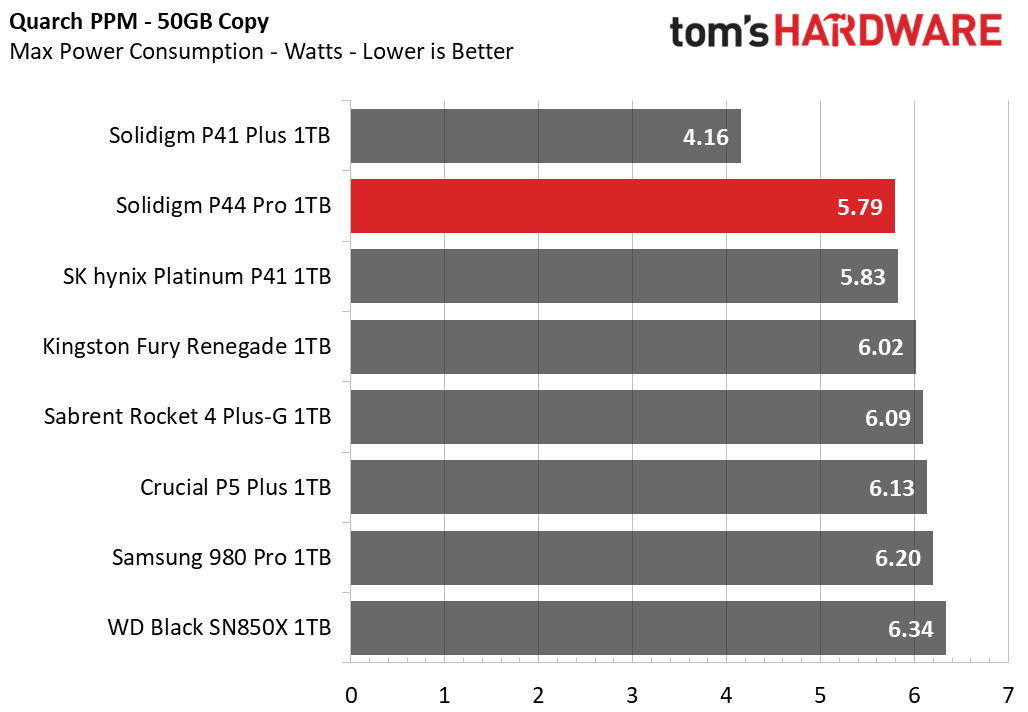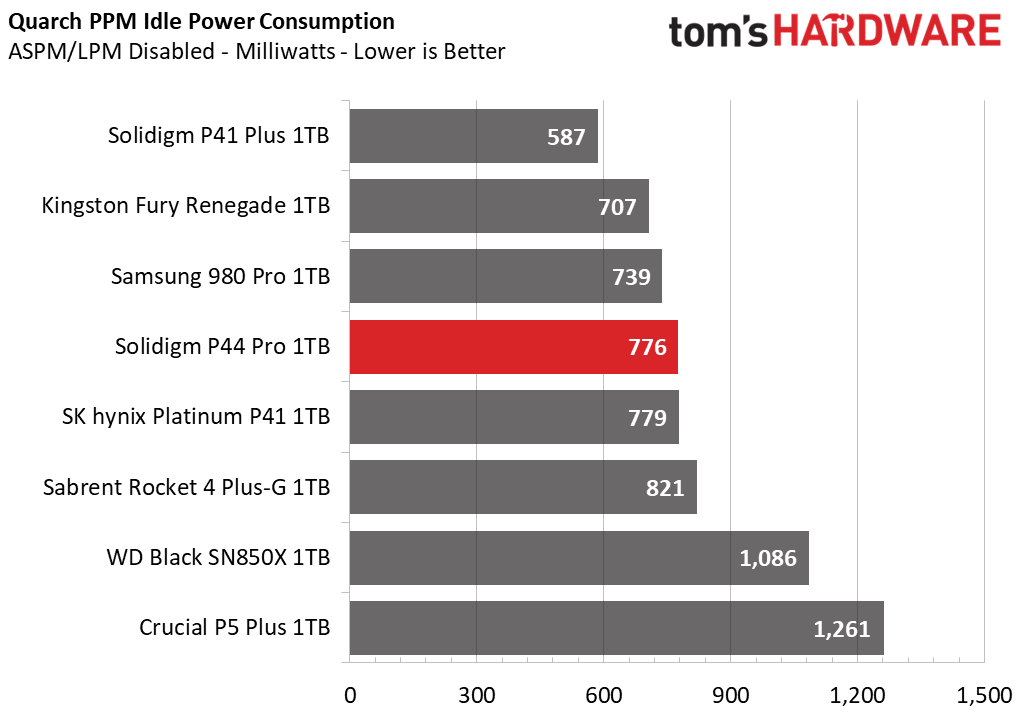Why you can trust Tom's Hardware
Comparison Products
The 1TB Solidigm P44 Pro is up against some very fast drives, such as the WD Black SN850X, the Kingston Fury Renegade, the Sabrent Rocket 4 Plus-G, the Samsung 980 Pro, the SK hynix Platinum P41, and the Crucial P5 Plus. Also tested is the Solidigm P41 Plus to give some idea on what you’re getting in a higher-end product.
Trace Testing - 3DMark Storage Benchmark
Built for gamers, 3DMark’s Storage Benchmark focuses on real-world gaming performance. Each round in this benchmark stresses storage based on gaming activities including loading games, saving progress, installing game files, and recording gameplay video streams.



The P44 Pro is the fastest drive we’ve ever tested in 3DMark at 1TB, as well.
Trace Testing – PCMark 10 Storage Benchmark
PCMark 10 is a trace-based benchmark that uses a wide-ranging set of real-world traces from popular applications and everyday tasks to measure the performance of storage devices.



The P44 Pro dominates in PCMark 10, too. This speaks well of SK hynix’s excellent new flash and its ability to optimize its controllers.
Transfer Rates – DiskBench
We use the DiskBench storage benchmarking tool to test file transfer performance with a custom, 50GB dataset. We copy 31,227 files of various types, such as pictures, PDFs, and videos to a new folder and then follow-up with a reading test of a newly-written 6.5GB zip file.



The P44 Pro is first in DiskBench, too, being the fastest 1TB SSD we’ve tested.
Get Tom's Hardware's best news and in-depth reviews, straight to your inbox.
Synthetic Testing - ATTO / CrystalDiskMark
ATTO and CrystalDiskMark (CDM) are free and easy-to-use storage benchmarking tools that SSD vendors commonly use to assign performance specifications to their products. Both of these tools give us insight into how each device handles different file sizes.












There are no issues with the P44 Pro’s ATTO performance. It’s not the best but the CDM sequential results show the drive can hold its own, with only a dip for QD1 writes. Random 4K QD1 latency is good but not the very best. The P41 Plus sibling struggles a bit more at 1TB with sequential performance due to dense QLC, but this is not an issue with 4KB performance.
Sustained Write Performance and Cache Recovery
Official write specifications are only part of the performance picture. Most SSDs implement a write cache, which is a fast area of (usually) pseudo-SLC programmed flash that absorbs incoming data.
Sustained write speeds can suffer tremendously once the workload spills outside of the cache and into the "native" TLC or QLC flash. We use Iometer to hammer the SSD with sequential writes for 15 minutes to measure both the size of the write cache and performance after the cache is saturated. We also monitor cache recovery via multiple idle rounds.





The 1TB P44 Pro manages almost 6.5 GBps in pSLC mode before falling to below 1.6 GBps afterwards. Both modes are a bit slower than they are with the 2TB model, but still very fast. The cache is a bit smaller on the 1TB capacity, but larger in relative terms at nearly 215GB. This underlines the fact that this hardware holds up better at 1TB than the competition. We have not yet benchmarked a 1TB 990 Pro, but as of now, the P44 Pro is the best drive on the market at this capacity in terms of overall performance.
Cache recovery is the same as with the 2TB model and the Platinum P41: fast for static, slow for dynamic. This is typical and is a good way to balance endurance and performance.
Power Consumption and Temperature
We use the Quarch HD Programmable Power Module to gain a deeper understanding of power characteristics. Idle power consumption is an important aspect to consider, especially if you're looking for a laptop upgrade as even the best ultrabooks can have mediocre storage.
Some SSDs can consume watts of power at idle while better-suited ones sip just milliwatts. Average workload power consumption and max consumption are two other aspects of power consumption, but performance-per-watt is more important. A drive might consume more power during any given workload, but accomplishing a task faster allows the drive to drop into an idle state more quickly, ultimately saving energy.
Temperatures are gauged at both idle and load states via sensor and an infrared thermometer. The typical ambient temperature is at 24C. The load state involves sustained writes at maximum speed with measurement ensuing if and until throttling is demonstrated to discover the equilibrium temperature.




The 1TB P44 Pro is extremely efficient, matching the class-leading Platinum P41, though it doesn’t quite see the edge that the 2TB model does. SK hynix and Solidigm have done an excellent job in optimizing this drive at all capacities. The P41 Plus, on the other hand, could use some work. However, that drive is using flash that originated with Intel and the controller is not proprietary, so we expect better things in the future for its lower-end options.
The 1TB model closely matched the 2TB in temperature testing. TLC writes are a bit faster at 2TB, 1.65 GBps versus the 1.5 GBps here, but both models throttled down to about 925 MBps after hitting 82C. A heatsink is again recommended.
Test Bench and Testing Notes
| CPU | Intel Core i9-12900K |
| Motherboard | ASUS ROG Maximus Z690 Formula |
| Memory | 2x16GB Corsair Dominator DDR5 5600 CL36 |
| Graphics | Intel Iris Xe UHD Graphics 770 |
| CPU Cooling | Arctic Liquid Freezer II - 420 |
| Case | Streacom BC1 Open Benchtable |
| Power Supply | Corsair SF750 Platinum |
| OS Storage | Sabrent Rocket 4 Plus 2TB |
| Operating System | Windows 11 Pro |
We use an Alder Lake platform with most background applications such as indexing, windows updates, and anti-virus disabled in the OS to reduce run-to-run variability. Each SSD is prefilled to 50% capacity and tested as a secondary device. Unless noted, we use active cooling for all SSD.
MORE: Best SSDs
MORE: Best External SSDs and Hard Drives
MORE: How We Test HDDs And SSDs
MORE: All SSD Content
Current page: 1TB Performance Results
Prev Page Features and Specifications Next Page 2TB Performance Results
Shane Downing is a Freelance Reviewer for Tom’s Hardware US, covering consumer storage hardware.
-
cyrusfox Refreshing to see a top end drive from Solidigm, although odd. As this is the P41 with Solidigm software and controller tuning. I would have thought they would repurpose their own NAND rather than used Hynix.Reply
Nice aggressive initial pricing as well for a top tier drive, this should be able to be found cheaper than the other 3 tops contenders (Sn850, 990 pro, & P41). Whatever happened to Kioxia(Toshiba) or Micron, they seem absent from the top of the line consumer pcie gen 4 ssd competition. Crucial P5 can't compete, not seeing any entries from Kioxia. -
anonymousdude Replycyrusfox said:Refreshing to see a top end drive from Solidigm, although odd. As this is the P41 with Solidigm software and controller tuning. I would have thought they would repurpose their own NAND rather than used Hynix.
Nice aggressive initial pricing as well for a top tier drive, this should be able to be found cheaper than the other 3 tops contenders (Sn850, 990 pro, & P41). Whatever happened to Kioxia(Toshiba) or Micron, they seem absent from the top of the line consumer pcie gen 4 ssd competition. Crucial P5 can't compete, not seeing any entries from Kioxia.
I think you may be misunderstanding the relationship between some of these companies. Solidigm is a subsidiary of SK Hynix created as a result of acquiring Intel's flash and ssd division, which to my knowledge was only making QLC NAND and Optane anyways. No controller either. So it's not weird at all that they use TLC Hynix flash and controller.
As for pricing, it is very competitive. The closest one at msrp is the P41 and that's $260. Granted these go on sale fairly frequently. Like the 2TB SN850x and P41 were $160 or so during Black Friday. I see the P41 pop up for around $210 too.
Kioxia doesn't really release to retail like this much anymore. They do have retail products, just not in high volume nor are competitively priced. Their history is fun too. WD acquired SanDisk back in 2016, who had a joint venture with Toshiba (Kioxia) for NAND fabrication and development which continues to this day. So WD drives have a custom controller with Kioxia's BICs NAND. You'll see the Kioxia name often though in pre-builts and laptops cause that's their target market.
Micron (Crucial) released the P5 Plus last year and it targeted the top 4.0 drives at that time. So the 980 Pro, SN850, and your pick of Phison E18 drive. It was competitive at that time and with its recent pricing is still a great value. It just so happens that everyone updated their drives this year. Samsung 990 Pro and WD SN850x. SK Hynix releases the P41 beginning of the year and now Solidigm with the P44. So mostly a case of bad timing on Micron's part is what gives you that feeling. -
thestryker It's not clear in the review whether or not the Solidigm Driver is used on the test system. Assuming it was were any tests done without it to see if it has an impact (or if it wasn't were any done with it)? I generally don't install storage drivers/software unless there's a specific reason to and was considering getting one of these.Reply
It is interesting to see where PCIe 4.0 drive performance has landed. Seems like this, the 990 and P41 will likely be the best choice of drive for some time even with PCIe 5.0 drives coming.
One note on Kioxia: they've been having financial and legal issues which seems to have impacted several of their latest technologies. I don't believe there are any gen1 XL-Flash devices on the market despite having their own line and one from Dapustor. They've even announced a second generation of XL-Flash without any products. -
Udyr I don't know why or how you're getting such high idle temps. My 1TB P41 idles at 27C, with an ambient temp of 24C, sandwiched between the CPU and GPU and no additional airflow other than the front fans.. When I had to transfer all my backup data (~700GB) from my trusty old HDD, the temperature went up by 12-13C, even after a couple hours of activity. Granted, I didn't run any synthetic benchmark, but seems odd the test yielded such high numbers.Reply -
DavidLejdar Nice. I have only one M.2 slot left, and looking to use that for a 4 TB drive eventually. But the test results seem to say that one shouldn't really see a difference between P44 Pro and i.e. 990 Pro in everyday use.Reply
And the cheaper price makes upgrading more affordable, which in turn means proliferation, which in turn means even more game devs making use of NVMe bandwidth, which in turn means that I may benefit too. :)
Udyr said:I don't know why or how you're getting such high idle temps. My 1TB P41 idles at 27C, with an ambient temp of 24C, sandwiched between the CPU and GPU and no additional airflow other than the front fans.. When I had to transfer all my backup data (~700GB) from my trusty old HDD, the temperature went up by 12-13C, even after a couple hours of activity. Granted, I didn't run any synthetic benchmark, but seems odd the test yielded such high numbers.
Even an active cooling for SSD may rely on there being air flow, like in a wind tunnel, which the test-rig apparently didn't have. And the heat-buildup near a SSD without such air flow, it may not really be that large for some convective heat dissipation to be going on. Well, at least that would be my guess about what could be a factor in regard to idle temperature. As for operating temperature, HDD can do around 100 MB/s (plusminus), and that's not really pushing a NVMe SSD, even if it took some time to move all that data. -
ReallyBigMistake solidigm is pronounced saa-luh-dime]I would have never figured that outReply
I can't wait for PCIe 5.0 SSDs to finally come out. -
DVDRDog I have to question where Shane got his specs for the Solidgn SSD's. For example he states warranty TBW. That seems to be the biggest secret on the Internet. Not even on the manufacturer's site is the warranted TBW for their Intel inherited SSD line. Does Shane Downing have some spiritual connection with SK Hynix and he has uncovered the big secret or is he fudging the numbers? I challenge Shane to back up his info with something legally binding in writing from the manufacturer or save this kind of speculation to social media where it belongs.Reply -
TesseractOrion Would a heatsink be recommended for a well ventilated case? I have six fans on various sides (front, top, bottom & back), but the NvME 4.0 slot is next to CPU and under GPU (though could move that).Reply
I have an AMD 5700X but only a Radeon 580X paired with it.
